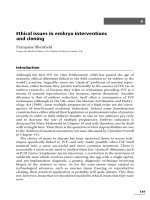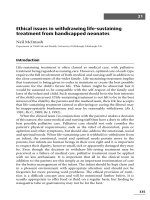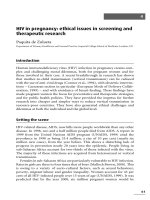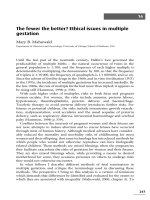Ethical issues in embryo interventions and cloning
Bạn đang xem bản rút gọn của tài liệu. Xem và tải ngay bản đầy đủ của tài liệu tại đây (130.1 KB, 12 trang )
9
Ethical issues in embryo interventions
and cloning
Franc¸oise ShenWeld
Centre for Medical Ethics, UCL Medical School, London, UK
Introduction
Although the Wrst IVF (in vitro fertilization) child has passed the age of
majority, ethical dilemmas linked to the Weld continue to be subject to the
world’s scrutiny. Arguably, some are ‘classical’ problems of assisted repro-
duction, either because they pertain intrinsically to the essence of IVF (as in
embryo research), or because they relate to techniques preceding IVF as a
means of assisted reproduction (for instance, sperm donation). Another
dilemma is that of embryo reduction, itself often a consequence of IVF
techniques (although in the UK, since the Human Fertilisation and Embry-
ology Act (1990), most multiple pregnancies of a high order are the conse-
quence of non-licensed ovulation induction). Indeed some Scandinavian
countries have either altered their legislation or professional codes of practice
recently in order to limit embryo transfer to one or two embryos per cycle
and to decrease the rate of multiple pregnancies. Embryo reduction is
discussed by Mary Mahowald in Chapter 16 and will, therefore, not be dealt
with at length here. Then there is the question of what responsibilities we owe
to the children of assisted conception (an issue discussed by Christine Overall
in Chapter 19).
The choice of issues to discuss has been narrowed down to newer tech-
niques speciWcally linked to IVF, and only made possible when IVF itself
matured into a more successful and more common treatment. There is
necessarily a more acute need to analyse these less ‘classical’ dilemmas, such
as ICSI (intra-cytoplasmic sperm injection), a revolution in the treatment of
subfertile men which involves micro-injecting the egg with a single sperm,
and pre-implantation diagnosis, a genetic diagnostic technique involving
biopsy of the embryo in vitro. As for the even newer issues related to
technological advances, such as ovarian tissue freezing or reproductive
cloning, their practical application is probably still quite distant. This does
not, however, mean that we should not tackle the ethical issues that they raise
now.
149
All these ‘micoethical’ issues should also be seen in the larger ‘macroethi-
cal’ context, including issues of social justice such as equal access to fertility
treatment. These are questions of public policy and funding of the health
system. It seems wrong for the patient’s chance of appropriate treatment to
be dictated by its cost (or cost-eVectiveness). However, although we know
that health expenses are increasing worldwide, the problem of eYcacious
spending on health is a political and ethical matter beyond the scope of this
chapter. It nevertheless deserves a mention, as ‘keeping to budget’ has now
become a major concern in health care choices all over the world (Hermeren,
1998). In passing, however, it is still puzzling to observe that in our wealthier
countries huge sums of money are spent at the end of life, whilst objectors to
the whole Weld of life-creating fertility treatment are still arguing that it is
money misspent on a ‘non-medical matter’ (ShenWeld, 1997).
In the Wnal section of this chapter I shall move on to ethical issues in
reproductive and therapeutic human cloning, brieXy drawing on arguments
about diVerence and identity from the French psychoanalytical feminist Julia
Kristeva (1991). Thus the choice in this chapter is necessarily somewhat
eclectic – even entire books dedicated to these issues cannot hope to be
exhaustive (e.g. ShenWeld and Sureau, 1997).
Embryo research and screening
Embryo research is necessary to the continual improvement of assisted
reproduction techniques such as IVF; yet it was also one of the most
contentious Welds when it began. As shown in a three-day meeting held in
December 1996 at the Council of Europe on the protection of the human
embryo, this essential question is still central. The meeting was held a month
after the Committee of Ministers of the Council of Europe had approved the
text of the Convention for the Protection of Human Rights and Dignity of the
Human Being With Regard to the Application of Biology and Medicine
(Convention of Human Rights and Biomedicine; (Council of Europe, 1996)).
Controversy over embryo research has been heightened since then by the
growing commercial importance of stem cells derived from embryonic and
fetal tissue (see Chapter 15).
The famous semantic debate over the term ‘pre-embryo’ actually obscures
the matter even further. Using the term ‘pre-embryo’ to refer to ‘the stage of
the conceptus for the interval from the completion of the process of fertilisa-
tion until the establishment of biologic individuation’ (Jones and Schrader,
1992) aroused suspicion that the embryo’s supposed human essence was
deliberately ignored or lessened by adding the preWx (Seve, 1994).
On a utilitarian argument, the improvement of success rates in IVF is
beneWcial to welfare; if IVF is morally acceptable, so is embryo research, the
150 F. Shenfield
latter being necessary to the improvement of the former. Both the Human
Fertilisation and Embryology Act (HFEA) 1990 and the July 1994 Loi reXect,
in the UK and France, the intensity and breadth of public concern in matters
of reproduction. Both avoid qualifying the status of the embryo as such,
within the only two categories known in law: ‘res’ (thing, property) or person.
The HFEA Code of Practice stresses ‘that the special status of the embryo is
fundamental to the provisions of the Act’ without deWning this special
quality, and French law underlines the respect due to the human body ‘as
soon as life begins’, without deWning this precise moment. French legislation,
however, makes the creation of embryos purely for research purposes a
criminal oVence (Loi no 94, Article 511, section 18).
Even if this utilitarian argument were accepted as uncontroversial – which
it is patently not – two further problems arise: the source of embryos, and
their fate. If non-viable embryos are to be preferred on the grounds that no
harm is done, less good may result – the results may not be easily applicable
to viable embryos. So perhaps abandoned or surplus embryos are to be
preferred. The two cases are diVerent – not all surplus embryos will be
abandoned. In English law any couple cryopreserving surplus embryos must
give consent and choose their fate (donation, research or destruction) when
the legal time limit for cryopreservation has elapsed. From May 1996 the
HFEA lengthened the statutory limit for cryopreservation of embryos, in-
itially Wve years, to 10 years within speciWc clinical settings and with consent.
The transition from Wve to 10 years led to a major public debate in 1996 in the
UK about the ‘abandoned’ embryos whose gamete providers could not be
traced. May one then use abandoned embryos, for which, by deWnition, there
would not need to be any consent, before they are due to be destroyed? This
could arguably be the case in settings where there is as yet no legislation, but it
is hard to imagine this within the UK setting, where the ultimate fate of the
embryo must be decided in advance by the provider couple at the time of
cryopreservation.
In most cases embryos used for research will in fact be destroyed, as the
safety of the potential child who might ensue cannot be assured, and it can
actually be argued that it would be unethical to replace such embryos in utero.
The possibility of cryopreservation of embryos since 1984 has enabled
couples to have further attempts at embryo transfer from one stimulation
IVF cycle. The availability of cryopreservation makes the creation of embryos
purely for research purposes even more controversial, but perhaps more
necessary – surplus or supernumerary embryos may be frozen for possible
later use, and might only be given for research once the couple have become
parents.
Once pre-implantation research on the embryo is accepted, it follows that
its status as a non-person is implicitly recognized. This is not because its
consent cannot be obtained, as parents are entitled in law to give consent on
151Ethical issues in embryo interventions and cloning
behalf of children below the standards of ‘Gillick competence’ (Gillick v West
Norfolk and Wisbech Area Health Authority, 1985), but rather because its
destruction is necessarily planned, distancing the embryo from full human
status. Where parental consent is recognized, the parent is expected to decide
in the best interests of the incompetent child; deciding to destroy the embryo
is ipso facto not in its best interests.
By deWnition, when the technique researched has proven to be safe and
useful, it may become therapeutic or diagnostic. Then the embryo concerned
may be allowed to fulWl its potential to become a person, which, in English
law, it does not become until born alive.
By contrast, therapeutic or diagnostic interventions may be performed for
the beneWt of the embryo. ICSI, for example, is one of the techniques that has
radically changed the outlook for male infertility – although it was sometimes
criticized for being used therapeutically when actually it was still in the
research stage. Here the beneWt lies in averting the possibility of transmission
of sex chromosome anomalies which might in particular threaten the future
fertility of the male child of an ICSI couple. Some have even advocated
pre-implantation diagnosis following ICSI, but this is arguably too powerful
a tool to use for what may be seen as only a moderately severe disability. This
leads us to consider the indications for pre-implantation diagnosis, and the
notion of ‘severe handicap’, already used in the terminology of legal termina-
tion of pregnancy. Embryo screening is not research, but neither is it necess-
arily therapeutic, at least so far as the embryo rather than the parents is
concerned.
Pre-implantation genetic diagnosis (PGD) triggers the fear of potential
genetic manipulation, and is often considered to be on the slippery slope to
criminal eugenics (Testard and Sele, 1995). If eugenics is deWned as a practice
imposed on a population, and not in terms of individual couples’ choice to
avert possible serious disease (e.g. cystic Wbrosis), this accusation founders
(ShenWeld, 1997). Other fears concern phantasmatic perversions of heredity,
or at least poorly controlled intrusions into the genome of germline cells. The
most complex ethical question is in fact not so much the current practice of
pre-implantation diagnosis, but rather what might be the consequences of its
evolving techniques. Will pre-implantation diagnosis lead couples to expect
the assurance of a ‘perfect’ baby?
This very point is alluded to in the joint public consultation document
published in November 1999 by the HFEA and the ACGT, spelling out that
neither body thinks it ‘would be acceptable to test for any social or psycho-
logical characteristics, normal physical variations, or any other conditions
which are not associated with disability or a serious medical condition’. The
questions for consultation centre around, but do not actually mention, the
distinction between positive and negative eugenics, perhaps because the
terms are so historically tainted (Missa, 1999). Instead the document concen-
152 F. Shenfield
trates on practical issues, within the context of licensing clinics for testing
speciWc inherited conditions and restricting access through guidelines that
limit which patients might avail themselves of PGD. Such questions have
already been asked in the context of antenatal screening in general. No
legislation that allows termination of pregnancy on the grounds of a ‘serious’
disorder has actually drawn up a list of the conditions that would qualify. It
seems appropriate to suggest that PGD could also be called Pre-Gravid
Testing, and that it can be compared to other forms of prenatal testing
already in place in many countries.
The speciWc ethical problems of pre-implantation diagnosis are also linked
to its particular constraints, especially the need to undergo IVF. It is thus
understandable that the more classical approach (prenatal diagnosis, possibly
followed by therapeutic termination of pregnancy) may sometimes be prefer-
red by patients. Studies have shown diVerent preferences according to the
past experience of the couples concerned and the gender of the potential
parent (Chamayou et al., 1998). In practice, it is for the time being a matter of
rather restricted choice, as the number of units available worldwide for this
technique is extremely limited, making it available only to a few prospective
parents. Needless to say, counselling is of great importance in all these
decisions. The need for long-term surveillance of this particularly ‘precious’
oVspring in turn entails recording the births and follow-up of the children
with their speciWc dilemmas already described in detail (Milliez and Sureau,
1997).
Another concern in pre-implantation diagnosis is the dilemma between
the fundamental principle of conWdentiality for the couple and the right to
privacy of the potential child, together with the psychological consequences
of intrusion for the children. The problem of conWdentiality with regards to
the child sometimes seems insoluble, as it entails a parental, if not sometimes
a state, decision, as is the case with non-anonymity of gamete donors in
Sweden. In this context it is useful to stress the responsibility that the adults
involved, carers as well as putative parents, have towards the vulnerable
future third party – the child to be. Fifteen years after implementation of the
law in Sweden, 89 per cent of the parents of sperm donor children still have
not informed them of their origins (Gottlieb et al., 2000), perhaps exemplify-
ing the complexity of this dilemma.
Cryopreservation of reproductive tissues
Fragility and vulnerability are also uppermost in issues concerning the
cryopreservation of reproductive tissues of adolescents who are suVering
from cancer, the treatment of which threatens their future reproductive
capacity. This is especially sensitive as reproduction is not a matter which
153Ethical issues in embryo interventions and cloning









